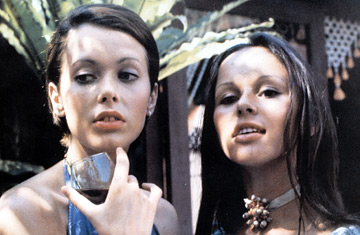
Sylvia Kristel and Christine Boisson in Emmanuelle.
Director: Just Jaeckin; Writer: Jean-Louis Richard, from the novel by Emmanuelle Arsan
With Alain Cuny, Sylvia Kristel, Marika Green, Christine Boisson
Lionsgate
"X Was Never Like This," the newspaper ads proclaimed when this French sexcapade opened at Manhattan's Paris Theatre in late 1974. In the brief era of porno chic, when films with hard-core sex were drawing millions of the curious into movie houses (no video back then), the soft-core, soft-focus adventures of Dutch ingenue Sylvia Kristel made a quiet sensation, and millions of dollars for Columbia, a major studio taking a fling in a flirtation with sexual explicitness. (One scene, of a Thai dancer blowing cigarette smoke out of an unexpected orifice, was cut from some U.S. prints.) Back then, the melange of exotic locations and acres of nakedness seemed both daring and soothing. These days a late-night viewer can't turn on Cinemax or Showtime without getting turned on, Emmanuelle-style. The standard set pieces of TV erotica — sex in an airplane, the night-club striptease, the Sapphic caresses, the whole kitten caboodle — come straight from this movie.
The film, directed by first-timer Jaeckin, had a few distinguished abettors. Scripter Richard, who had written The Bride Wore Black and Day for Night with François Truffaut, got no screen credit on Emmanuelle but did negotiate 8% of the profits. Another Truffaut alum, Claudine Bouché, served as editor. The male star was Alain Cuny, who had played romantic leads in top French films of the 40s and the suicidal philosopher Steiner in Federico Fellini's international hit La Dolce Vita. But it was Kristel, a 21-year-old model with a pretty face and an evident pleasure in displaying her slim, luscious figure, who closed the deal. Veteran stunner Marika Green (aunt of current European screen siren Eva Green) and teenage Christine Boisson added to Emmanuelle's unabashed allure.
The film was a huge hit in France, running for 11 years in one Champs Elysées theater, and duplicated its success in the States. That the movie was in French (a language Kristel didn't speak) only added to its panache for American moviegoers who still looked to France as the repository of sexual elegance. Emmanuelle spawned two official sequels with Kristel, and at least 50 low-budget ripoffs, from the Laura Gemser Black Emmanuelle to Las Orgías inconfesables de Emmanuelle from legendary sub-basement Spanish auteur Jess Franco.
In a 54 min. extra, An Erotic Success: The Making of Emmanuelle, the prime tale-tellers are Bouché and Richard Suzuki, the cinematographer who also served as second-unit director and, in a horse-riding long shot, stunt double for Mlle. Kristel. They detailed the tyro director's difficulties putting tender passion on film, the antagonism Cuny provoked on the set and the concerns expressed by producer Yves Rousset-Rouard. It's an informative little testament to filmmaking serendipity. It might even be true.
The argument made in the 70s that Emmanuelle was an expression of feminist erotic liberation isn't so persuasive now. The heroine spends much of her time being bossed around (and in one scene sexually brutalized) by her husband, her girlfriends and Cuny. She's at best a very willing slave. And as Bouché notes, the movie was not very good, but it purveyed a "soft and chic eroticism. It looked like those posh magazines with photographs of nude women." So if, today, Emmanuelle has the nostalgic naughtiness of an old, dog-eared copy of Playboy, it also has Kristel and those other lovely women, still young and animated, taking their pleasures for the delectation of viewers who want to keep in touch with their adolescent erotic dreams.